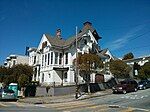San Francisco Mint
1854 establishments in California1870s architecture in the United States1874 in California1930s architecture in the United States1937 in California ... and 18 more
California Gold RushCoin article with no obverse imageCoin article with no reverse imageGovernment agencies established in 1854Government buildings completed in 1874Government buildings completed in 1937Government buildings in San FranciscoGovernment buildings on the National Register of Historic Places in San FranciscoManufacturing plants in the United StatesMints of the United StatesModerne architecture in CaliforniaNational Historic Landmarks in the San Francisco Bay AreaNeoclassical architecture in CaliforniaSan Francisco Designated LandmarksSouth of Market, San FranciscoStripped Classical architecture in the United StatesUnited States MintWestern Addition, San Francisco

The San Francisco Mint is a branch of the United States Mint. Opened in 1854 to serve the gold mines of the California Gold Rush, in twenty years its operations exceeded the capacity of the first building. It moved into a new one in 1874, now known as the Old San Francisco Mint. In 1937 Mint operations moved into a third building, the current one, completed that year.
Excerpt from the Wikipedia article San Francisco Mint (License: CC BY-SA 3.0, Authors, Images).San Francisco Mint
Buchanan Street, San Francisco
Geographical coordinates (GPS) Address Nearby Places Show on map
Geographical coordinates (GPS)
| Latitude | Longitude |
|---|---|
| N 37.7701 ° | E -122.4273 ° |
Address
United States Mint
Buchanan Street
94143 San Francisco
California, United States
Open on Google Maps







